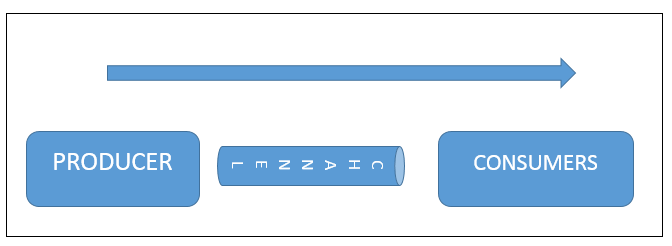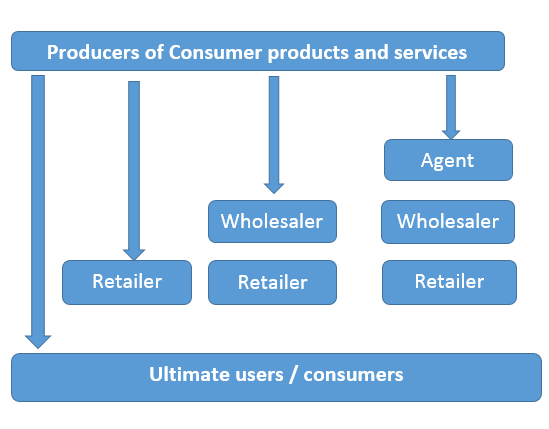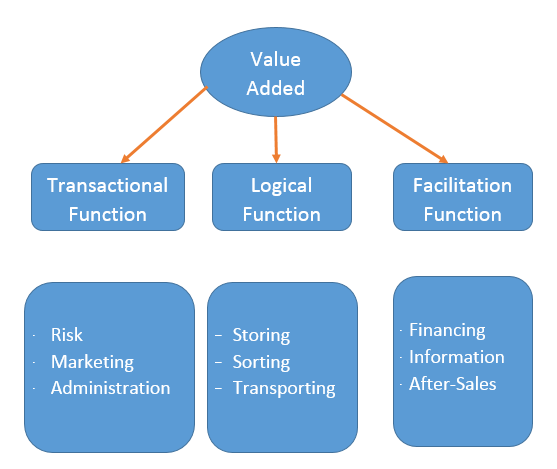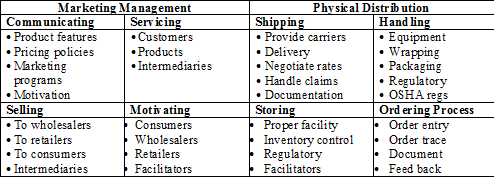Designing and Managing Marketing Channels
Marketing channels are set of mutually dependent organizations involved in the process of making product or service available for utilization. It is established in academic studies that Marketing channels are the means by which goods and services are made available for use by the customers. All goods go through channels of distribution, and marketing will depend on the way goods are distributed. The direction that the product takes on its way from production to the consumer is imperative because a marketer must choose which channel is best for his particular product. It can be said that channel is the link between manufactures and purchasers. Decisions about the marketing channel system are decisive for management.
The marketing channels chosen by marketers influence all other marketing decisions. The firm’s sales force and advertising decisions depend on how much training and inspiration dealers need. Further, channel decisions involve comparatively long-term commitments to other firms. Holistic marketers guarantee that marketing decisions in all these different areas are made to jointly maximize value.
Channel of distribution (Marketing channel)
In current competitive climate, big companies are using hybrid channels in any one area. The firm must choose how much effort is needed to assign to push versus pull marketing. A push strategy uses the manufacturer’s sales force and trade promotion to encourage intermediaries to carry, promote, and sell the product to customers. This is suitable where there is low brand loyalty in a category, brand choice is made in the store, the product is desired item, and product benefits are well understood. In a pull strategy, the manufacturer uses advertising and promotion to influence customers to ask intermediaries for the product, thus inducing the intermediaries to order it. This is suitable when there is high brand loyalty and high involvement in the category, people perceive differences between brands, and people choose the brand before they shop. A marketing channel executes the work of moving products from producers to consumers, beat the time, place, and possession gaps that separate goods and services from those who need or want them.
Channel level: The producer and the final customer are part of every channel. There are numerous channels by which goods and services are distributed. It is divided into direct and indirect channel. In direct channel also known as zero-level channel, manufacturer and customer deal directly with each other. There is no middleman in this channel. It consists of a producer selling directly to final customers through door-to-door sales, Internet selling, mail order, telemarketing, home parties, TV selling, manufacturer-owned stores, and other methods.
In indirect channel, companies manufacture products in huge scale and sell these products to middle man for example whole seller and retailers. This channel can be very expensive.
Manufacturer to Customer: Manufacturer produces the goods and sells them to the customer directly with no mediator, such as a wholesaler, agent or retailer. Goods come from the manufacturer to the user without an intermediary.
Manufacturer to Retailer to Consumer: Purchases are made by the seller from the manufacturer and then the retailer sells the products to the consumer. This channel is used by manufacturers that specialize in producing shopping goods.
Manufacturer to Wholesaler to Customer: Consumers can buy directly from the wholesaler. The wholesaler breaks down bulk packages for resale to the consumer. The wholesaler reduces some of the cost to the consumer such as service cost or sales force cost, which makes the purchase price cheaper for the consumer.
Manufacturer to Agent to Wholesaler to Retailer to Customer: This type of distribution involves more than one intermediary involves an agent called in to be the middleman and help with the sale of the goods. An agent receives a commission from the producer. Agents are useful when products or services need to move rapidly into the market soon after the order is placed.
Market channels by which goods and services are distributed
Characteristics of Marketing Channels
Link between Producer and Consumer.
Flow of Goods
Remuneration.
Classification-Direct and Indirect.
Activities- Financing, Credit Facility
It is important to consider some factors when choosing appropriate marketing channel such as product, market, company. It is observed that middle man plays vital role in distribution of product in market channel. The core responsibility of intermediaries is to deliver products to customers in their desired location. To accomplish this objective, they purchase goods and store these and then ship to customers.
marketing channel function performed by middleman.
Designing a Marketing Channel System
Designing a marketing channel system entails factors such as analysing customer needs, establishing channel objectives, identifying major channel alternatives, and evaluating major channel alternatives.
Analysing Customers’ Desired Service Output Levels: The marketer must recognize the service output levels which its target customers want. Channels produce five service outputs:
- Lot size: The number of units the channel allows a particular customer to buy at one time.
- Waiting and delivery time: The average time consumers of that channel wait for receipt of the goods. Customers generally prefer fast delivery channels.
- Spatial convenience: The extent to which the marketing channel facilitate for customers to obtain the product.
- Product variety: The variety provided by the channel. Usually, consumers prefer a greater collection, which enhances the chance of finding what they need.
- Service backup: The add-on services such as credit, delivery, installation, repairs provided by the channel.
Providing greater service outputs denotes increased channel costs and higher prices for consumers. The triumph of discount resellers (online and offline) designates that many consumers will accept lower outputs if they can save money.
Establishing Objectives and Constraints
Another factor in designing a marketing channel system is that marketers must declare their channel objectives in terms of targeted service output levels. In competitive conditions, channel institutions should coordinate their functional tasks to reduce total channel costs and still offer desired levels of service outputs. Generally, planners can recognize several market segments that want different service levels. Successful planning needs to determine which market segments to serve and the best channels for each. Channel objectives differ with product characteristics. Channel design is also affected by numerous environmental factors as competitors’ channels, monetary conditions, and legal regulations and limitations.
Identify Major Channel Alternatives
Other decisive factor in developing market channel is to recognize alternatives. Companies may select array of channels to approach customers, each of which has distinctive strengths as well as limitations. Each channel alternative is explained by (i) the types of available intermediaries (ii) the number of intermediaries needed; and (iii) the terms and responsibilities of each channel member. Types of Intermediaries entails a firm needs to discover the types of intermediaries available to run its channel work. Some intermediary merchants such as wholesalers and retailers buy, take title to, and resell the products. Agents such as brokers, manufacturers’ representatives, and sales agents chase customers and may bargain on the producer’s behalf but do not take title to the merchandise. Facilitators, including transportation companies, independent warehouses, banks, and advertising agencies, help in the distribution process but neither take title to goods nor negotiate purchases or sales.
Companies should recognize pioneering marketing channels. Number of Intermediaries indicates that to choose intermediaries to use, companies can adopt one of three strategies: exclusive, selective, or intensive distribution. Exclusive distribution means severely limiting the number of intermediaries. Selective distribution depends on more than a few but less than all of the intermediaries willing to carry a particular product. In intensive distribution, the producer places the goods or services in as many outlets as possible. This strategy is usually used for items such as snack foods, newspapers, and gum. Terms and Responsibilities of Channel Members signify that each channel member must be treated courteously and given the opportunity to be lucrative. The main constituents in the “trade-relations mix” are price policy, conditions of sale, territorial rights, and specific services to be performed by each party. Price policy assists the producer to ascertain a price list and schedule of discounts and allowances that intermediaries see as equitable and sufficient.
Evaluating the Major Alternatives
The Company must assess each alternative against suitable economic, control, and adaptive criteria. The firm should verify whether its own sales force or a sales agency will create more sales and it estimates the costs of selling different quantities through each channel.
Managing Marketing Channel
In order to maximize profit, companies must manage their marketing channel effectively. Management of marketing channel refers to the process of analysing, planning, organizing and controlling its marketing channel. In marketing channel two different activities occur. One is the establishment of physical distribution system and other is management of marketing objectives. Management of marketing channel involves all functions of marketing mix which include product, price, physical distribution, program and people. The physical distribution system and channel structure is established through which products flow in the marketing channel.
Marketing Mix Activities In Marketing Channel Management: (McCalley, 1996)
To Mange marketing channel, firms must adopt motivational strategies such as paying higher slotting allowances, offering higher trade discount, providing strong promotional and advertising support, training channel member sales people, giving high level logistic support. Management professional stated that after a firm has selected a channel system, it must select, train, motivate, and evaluate individual intermediaries for each channel. It must also modify channel design and arrangements over time.
Selecting Channel Members: For successful management, Companies must have to choose talented channel members cautiously because for customers, the channels are the company. Producers should decide what features distinguish the better intermediaries and scrutinize the number of years in business, other lines carried, growth and profit record, financial strength, cooperativeness, and service reputation of potential channel members. If the intermediaries are sales agents, producers should assess the number and character of other lines carried and the size and quality of the sales force. If the intermediaries want exclusive distribution, the manufacturer should assess locations, future growth potential, and type of customers.
Training and Motivating Channel Members: It is a major responsibility of a company to examine its intermediaries in the same way it views its customers. It needs to establish intermediaries’ needs and build a channel positioning such that its channel offering is tailored to provide superior value to these intermediaries. To enhance intermediaries’ performance, the company should offer training, market research, and other capability-building programs. The company must also continually strengthen that its intermediaries are to jointly gratify the needs of end users. Producers differ greatly in channel power, the ability to change channel members’ behaviour therefore the members take corrective actions. Often, gaining intermediaries’ collaboration is a major challenge. Sometimes, Producers try to forge a long-term affiliation with channel members. The manufacturer must talk clearly what it expects from its distributors in the way of market coverage and other channel issues and may ascertain a compensation plan for adhering to these policies. Motivating channel members takes numerous forms in order to gratify the requirements at each level in channel. Profitability is major Motivational force for whole seller for product selection. When profit motivation is satisfied, whole seller will look for marketing programs offered by producers to sell products to retailers. Whole seller checks the credit option and terms of payment when assessing the profit option for business when dealing with particular supplier. Retailers are mainly concerned with maintenance of product supply and availability. It is observed in market that when customers cannot get product in one retail shop, they immediately search for it in another retailers. But retailers do not want to lose customers. Another interest of retailers is profitability of the product.
Motivational consideration for channel members: (McCalley, 1996)
Evaluate Channel Members: To successfully manage market channel, producers must assess intermediaries’ performance at regular intervals against such standards as sales-quota attainment, average inventory levels, customer delivery time, treatment of damaged and lost goods, and cooperation in promotional and training programs. A producer will occasionally determine that it is paying particular intermediaries too much for what they are actually doing. Producers should establish functional discounts in which they pay specific amounts for the intermediary’s performance of each agreed-upon service. People who are not performing must be given extra training or counselling.
Modifying Channel Arrangements: Channel arrangements must be reassessed regularly and altered when distribution does not work as planned, consumer buying patterns change, the market develops, new competition occurs, inventive distribution channels appear, and the product moves into later stages in the product life cycle. No marketing channel remains successful over the entire product life cycle. Early purchaser might be willing to pay for high-cost value-added channels, but later buyers will change to lower-cost channels. In highly competitive markets with low entry barriers, the best channel structure will transform over time. The company may add or drop individual channel members, add or drop particular market channels, or develop a new way to sell merchandise. The process of adding or dropping an individual channel member needs an incremental analysis to decide profitability of company. Additionally, marketers adopt data mining to analyse customer shopping data as input for channel decisions. The most complicated decision is whether to modify the overall channel scheme. Channels can become old-fashioned when gap occurs between the existing distribution system and the ideal system to gratify customer’s needs and wants.
The most challenging face of channel management is the maintenance of control over all parts of distribution flow and marketing activities. Marketers have to undergo legal issues in controlling marketing channels therefore they need to develop successful channel programs that will stimulate the action planned without creating conflict among competitive channel members.
To summarize, market channel is medium through product from raw material move to costumer. In designing market channel it is important to comprehend customer’s need. The task of managing marketing channel falls to marketing and sales managers. These people directly involve with channel members and company’s competitors. They know how to find valuable information for good management decisions. To organize marketing channel, it is imperative to gather relevant information. It assists in writing accurate and detail market profile statement. Most marketing channels are created with one or more intermediaries between the manufacturer and consumer.

